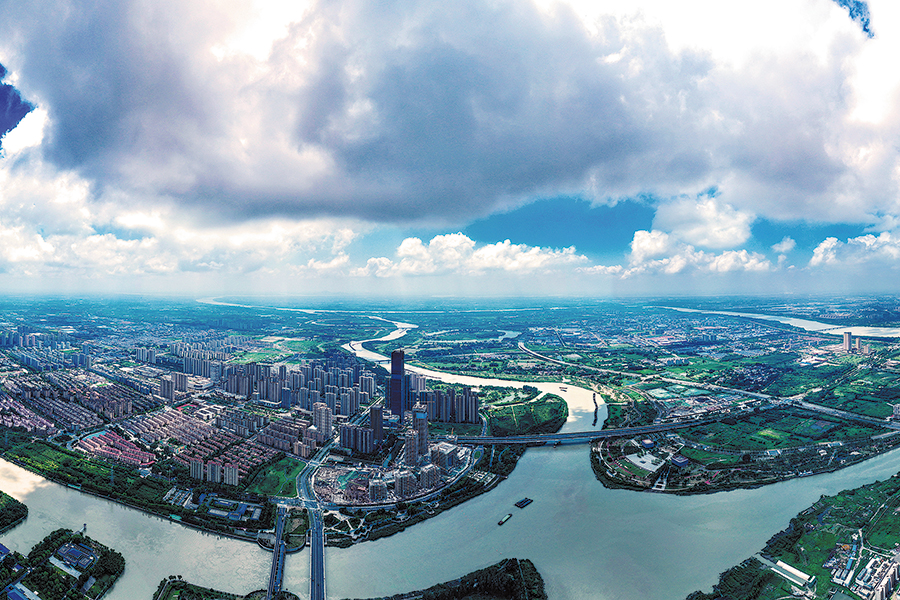Water diversion project brings many benefits

Water is drawn for the eastern route of the South-to-North Water Diversion project from the lower reaches of the Yangtze River at Jiangdu in Yangzhou city, Jiangsu province. YU XING/FOR CHINA DAILY
Relief provided for eastern areas long plagued by drought
The sun shone brightly as my father carried water from a small pond in a metal bucket, scrambling to fill a makeshift tank on our tractor bed.
After days of scorching temperatures, the pond was one of the few water bodies in our village that still had supplies, but the water level was low. This meant my father had to walk a long way on a slippery slope to reach the water.
As it was so hot, he removed his shirt, and sweat streamed down his face. His shoulders and part of his back were sunburned.
At that time in the mid-1990s, I was just a young boy, and although I was there to help, I cannot recall exactly what I did.
This childhood memory suddenly returned to me this month as I stood in a control center for the eastern route of the South-to-North Water Diversion Project.
Mo Zhaoxiang, head of the information center at Jiangsu Water Source Co in Nanjing, capital of Jiangsu province, said that with a simple click of a computer mouse, water pumps up to 400 kilometers away will start operating in just five seconds.
Pumping stations in Jiangsu along the route can deliver 100 cubic meters of water per second all the way to the north.
I was on an interview tour ahead of the 10th anniversary of the eastern route starting operation on Nov 15, 2013.
Water is drawn for this route from the lower reaches of the Yangtze River at Jiangdu in Yangzhou city, Jiangsu. The ancient Beijing-Hangzhou Grand Canal and its parallel rivers are used to divert water to northern China through a series of pumping stations.
One of the destinations water is diverted to is my hometown of Weihai in the most easterly part of Shandong province.
Facing the sea in all directions but the west, Weihai was once plagued by a water shortage.
The makeshift tank on our tractor bed, which was made from thin plastic, could only hold about 5 cu m of water. After filling it up, my father drove the tractor to our farmland about 2 kilometers away to water corn seedlings, which were severely parched due to persistent drought.
There was no cover for the tank, so after bumping along a rugged country road for about 10 minutes, we had lost at least 0.5 cu m of water.
Each of the corn seedlings on our 0.13 hectares of farmland could only be given water from two large ladles made from gourds.
My father and I were not alone in fetching water from the small pond, and it was quite a chaotic scene. There were so many tractors that it took at least five minutes to escape the traffic jams, although the size of the pond could be compared to that of a basketball court.
Such scenes were familiar to residents in Weihai, who had been fighting drought for generations.
Key points
On a big screen at the water diversion project's control center, a large electronic map shows key points on the eastern route. One end of the route is the Mishan Reservoir in Weihai, which I am familiar with, as my grandfather-in-law helped build it.
A participant in the Huaihai Campaign, one of the three major battles in the War of Liberation (1946-49), he never shared his wartime experiences with me. However, he told me some of his memories of building the reservoir, one of whose major functions was to store water to help with drought relief.
He was one of more than 10 young laborers designated by his village committee to help build the reservoir. The laborers lived on the construction site for three months in tents. Despite having no wages, they had to carry all their food and other necessities, and also cook for themselves.
With no support from machinery, they worked simply, carrying shoulder poles and large baskets. After continuous efforts from numerous groups of young laborers from different villages, the reservoir was completed in 1960, although I don't know how long the construction took.
As the largest reservoir in Weihai, it can hold 280 million cu m of water.
In 2005, I left Weihai for university, and since then I have seldom stayed in the city for more than a week, but I still hear frequent accounts of how drought wreaked havoc in my hometown.
My mother once phoned me to say the water supply to the middle school in our village had been disrupted because of drought, and students boarding at the school had no water to wash their clothes or take a shower. They discarded numerous towels, as they had been used for a long time without being washed.
Such scenes may never happen again in many areas of Shandong, thanks to the giant water diversion project.
When Weihai and the nearby cities of Qingdao, Yantai and Weifang experienced a prolonged drought from 2014 to 2018, the project delivered water to the four cities for 893 consecutive days. The China Eastern Route Corp of South-to-North Water Diversion said it transported more than 2.5 billion cu m of water to the drought-hit areas.








